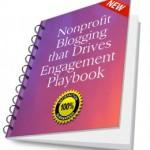
Is Your Newsletter Giving You a Bang for Your Buck?
Does your nonprofit have an email newsletter?
I’d rather see you rock a blog, but let’s talk a bit about your newsletter. Since you already have one, you may as well make it better.
Otherwise, what’s the point?
[BTW: If you don’t have an e-newsletter, go read the article above about creating and rocking a blog. Also read this. A blog can serve the purpose of an e-newsletter, and do so in a more donor-centric, user-friendly fashion. IMHO]
Okay. Back to improving your newsletter.
The real point of a newsletter is to stay top of mind with your supporters.
Why?
Because you want to keep them, of course!
Just like with any relationship, if the only time someone hears from you is when you want something from them, they’re not likely to stick around.
What Newsletters are For
Let’s begin with what they’re not for. They don’t exist so that you can:
- Have a platform for telling donors what you want to tell them.
- Brag about how great you are.
- Check something off your list as ‘done’ in order to justify your job
They do exist so donors can:
- Hear from you what they want to hear.
- Learn more about the outcomes they made possible.
- Get some useful information that adds meaning and pleasure to their lives.
- Feel appreciated.
- Feel special.
- Feel good.
How Often You Should Publish
Ideally, you should publish when you have news.
After all, it’s called a “news”letter.
Interestingly, when Penelope Burk conducted her groundbreaking research for Donor-Centered Fundraising she found that donors preferred more frequent, briefer mailings. They’d rather get one page of “news” than a completely filled newsletter jammed with junk.
What’s junk?
- Anything that isn’t news.
- Anything that isn’t useful.
- Anything that isn’t donor-centered.
If your newsletter is templated and always has the same elements (e.g., “Letter from the E.D.;” “Volunteer Corner;” “Program Highlight;” “Donor Profile;” “Client Profile;” “Events;” “Ways to Give,” and so forth), then you’re committing yourself to filling those buckets every time you publish – be in monthly, quarterly or something else.
Sometimes you won’t have anything good to include in one or more buckets. So you’ll fill it with stuff that even you find boring.
Sometimes you’ll be inundated with other work when your deadline looms, so you’ll fill it with retreaded articles that definitely don’t qualify as “news.”
ACTION TIP: I know you’ve heard advice to publish monthly online, and maybe quarterly offline. I’m not suggesting you shouldn’t have a schedule. It’s good to be consistent.
BUT… quality trumps quantity. Prioritize quality when it comes to creating newsletter content.
It doesn’t matter if you publish monthly if no one reads what you write. Or, if no one acts as a result of what you write.
What Should Be Included
1. Well, first off, “news” — of course.
Think about stories that appear in the newspaper. What makes them interesting? Relevant to the readers?
I’ll tell you one thing you won’t find. Stories about how the newspaper just brought in some new sponsors. Or who they just added to their board. Or who they just hired to edit copy. Or how they’ve rebranded their website. These are organization-centric bits and pieces of information about which most of their readers have zero interest.
Are you reporting any of these kinds of “stories” in your newsletter?
2. Which leads to the next thing to include – stories.
Human beings are wired for stories. They draw us in like nothing else.
Remember, a story that draws people in has a beginning, middle and end. You should be able to begin it (at least in your mind) with “Once upon a time.” Then the story should have a protagonist with whom the reader can identify and/or empathize. The protagonist should have obstacles in their way and challenges to overcome. The clear path to victory should be the donor as the hero.
Your stories need not be long. In fact, micro content can be a great way to go. It’s easier for your reader to digest, and it takes less time for you to create. If you want, you can write a brief story and then include a link to your website where the story concludes (and you can have a “donate” button on the page to which you send folks).
4. Which leads right into the next thing to include – a call to action.
Why are you sending this newsletter in the first place?
Remember, it’s not to check it off your list as “mission accomplished.”
It’s to get your reader to feel, think, share, engage, invest or otherwise do something.
Does your newsletter have clear calls to action for every included item?
ACTION TIP: Take a look at your last newsletter, and ask how you could have included an action item.
Some ideas:
- Share this article with a friend (have clear, easy-to-use, share buttons).
- Sign this petition.
- Phone your representative.
- Attend this event.
- Connect to volunteer.
- Download this free “How To” video.
- Get this recommended reading list.
- Make this recipe and pin the results to our Pinterest board.
- Donate to help fund this project.
- Send us your feedback.
- Complete this survey.
5. Information that helps, not sells.
This is the key to successful content marketing.
Jay Baer of “Convince and Convert” and I agree that your future success depends on your ability to help people, not “sell” to them.
ACTION TIP: Ask yourself what is relevant and valuable to your audiences. Think in terms of what Jay Baer calls “youtility.” How useful is your content? I’m sure if you look around you’ll find all sorts of valuable, underused content. Stuff that your constituents could use. Maybe it’s “Tips to Babyproof Your Home” that you use in a workshop. Or a “Recommended Reading List” that you share with participants in one of your programs. Or even healthy recipes your staff shares with one another. Get creative!
ACTION TIP: Step into your donors’ truths. Stop talking about why you believe what you’re saying to be true. Instead, take your donor’s point of view and make your arguments with empathy. Stand in their shoes. What’s in this for them?
ACTION TIP: Think carefully about how you disseminate your content. Your newsletter may not always be your best bet. Sometimes a blog, or email or even a tweet may be more effective. [Learn more in When to Think Inside the Box: Choosing the Best Nonprofit Content Marketing Platform].
6. Visuals
A picture really is worth 1000 words. More people will look at compelling photos, videos and infographics than will read your carefully crafted prose.
Spend some time taking, or finding, good visuals that will draw your readers in and tug at their heartstrings.
Final Thoughts
If you’re just bragging about how great you are, or what you believe is interesting, then you may be creating “top of mind awareness” among your target constituents. But it will do you little good.
If you inspire folks and actively engage them, they’ll stay interested. They’ll stick around. They’ll give, and keep giving.
Use newsletters to stay top of mind and show your donors you care about them for more than their wallets. Properly executed, they can be a great tool to show your donors how much they’re valued – which sets the stage for fundraising.
P.S. A blog accomplishes this even better than a newsletter, because it’s designed to offer up brief, frequent, tasty morsels. SO… give it some thought!
WANT TO ROCK A NONPROFIT BLOG?

4 Companion Volumes to drive awareness and support
You may be interested in my Nonprofit Blogging Playbook. A great blog is one of the best investments you can make in acquiring and retaining more donors. Learn how with this 4-volume set that will teach you:
- blog fundamentals;
- content folks will want to read;
- how to use your content to engage folks, and
- how to promote your blog so it builds momentum and drives more potential supporters to your website.
If you buy all four, I offer a “Bundle Bargain” discount). If you’re a paid Clairification subscriber, you get an additional 50% off! Plus, I stand by all my Clairification products. If you’re not happy, there’s a no questions asked full refund policy. The only way to lose is by doing nothing.
-
Pingback: 5 Secrets to Inspire Action on your Nonprofit Appeal - c ( group
-
Pingback: Nonprofit Newsletters Donors Abhor





